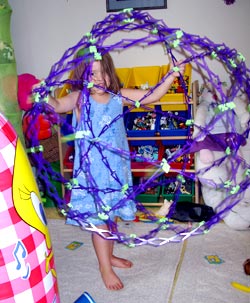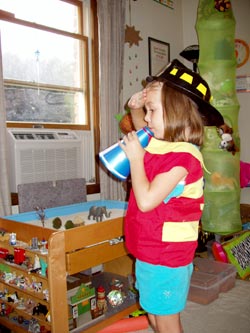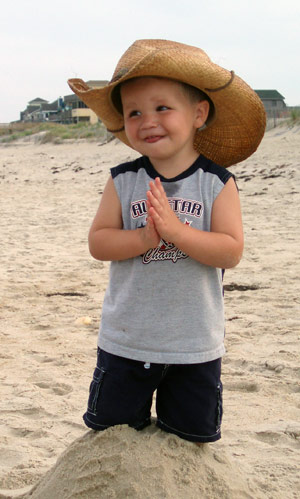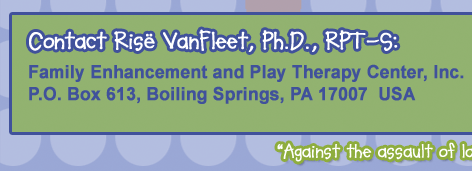 |
         |
 |
Welcome
to our page for parents! We hope to provide useful information
here for parents about the value of play in child development and family
life as well as some descriptions and tips about play therapy. If
you have questions or comments, don't hesitate to e-mail us!
Articles
Stay tuned! Please visit us again for new articles
added to this section.
 What is Play Therapy? What is Play Therapy?
[Parts
of this section are adapted from VanFleet, 1998, A Parent's Guide to
Filial Therapy. Printed
in VandeCreek, Knapp, & Jackson (Eds.), Innovations in Clinical
Practice: A Source Book (vol. 16). Sarasota, FL: Professional
Resource Press, PO Box 15560, Sarasota, FL 34277.]
You may
have heard about play therapy in several different ways. Perhaps
you simply came upon this website as you were exploring the internet. Perhaps
you heard or read about it. Perhaps someone has suggested that
your child receive play therapy. So what is it anyway?
Play therapy
is a type of mental health, educational, or developmental intervention
that is designed to help children grow up as happy and well-adjusted
as possible. It involves the use of play to communicate with
children and to help children learn to solve problems and change
their negative behaviors. Sometimes it involves the entire
family.
At first,
you might wonder why anyone would suggest play as a way to overcome
children's problems. Here's why play therapy is often recommended
for children: Play is the primary way that children...
• learn
about the world
• understand how different things work
• express their thoughts and feelings
• develop their physical skills
• develop their mental skills
• develop effective social skills and bonds.
As children
grow, their use of language becomes more sophisticated, but throughout
childhood, they usually express much more of themselves in their
play. We can understand our children better if we understand
their play. By watching children play we often learn more about
their thoughts, feelings, motivations, and struggles than by talking
with them! Play has been called the "language of childhood," so
if we re-learn that language, it can help us build even stronger
relationships with our children. Play is not something trivial;
on the contrary, it is one of the most critical elements of healthy
child development!
Perhaps
you've seen some of the nature programs on television that show animal
babies playing with each other or with their mothers as they develop
their hunting and survival skills. Scientists generally agree
that play fosters healthy development of young and adult animals
alike. A long-term study of animal play in the wild reported
in National Geographic (December 1994) suggests that play is a "rehearsal
for the challenges and ambiguities of life." This leads
to greater strength, increased physical and mental skills, improved
judgment, greater security, and stronger social bonds, characteristics
that contribute to success as the animal grows.
The same
is true for human children and adults. Playfulness and humor
are closely related to mental health, intellectual development, creativity
and problem-solving, and even productivity on the job! Although
we sometimes think of play as trivial, in actuality it is one of
the strongest supports for coping, learning, good adjustment, and
productive activity! I have spent some of my work life in manufacturing
companies where the work is hard and the physical environment (& sometimes
the overall climate) is very unpleasant. I have always been
impressed with the way that people use humor and playfulness to cope
with some of the most difficult and oppressive situations. I've
seen the same thing in medical environments where people are coping
with serious illness or in traumatic situations where people have
lost all their possessions. Humor and play help us get through
tough times.
How is
play therapeutic?
Play therapy creates a safe atmosphere where children
can express themselves,
try new things, learn more about how the world works, learn about
social rules and restrictions, and work through their problems. Play
therapy gives children an opportunity to explore and open up more
than usual.
When we,
as adults, encounter a tough problem, we often think about it for
a while, look at it from different angles, determine our options,
and sometimes talk about it with someone we trust. When things
go wrong for us, we might mentally review what happened and think
about how we might handle the situation in the future. During
play therapy, children do these same things using their imaginations. Play
therapy provides the tools (toys and activities) and the atmosphere
to help children express themselves, work on their problems, "try
on" different solutions, and learn more effective coping methods.
What
happens in play therapy?
Actually
there are many different types of play therapy, so what
happens in a session can be quite varied. The common
aspects are that the therapist holding the session will
know how to systematically use play or playful activities
to communicate with the child. (See the article on
this website about how to select a play therapist.) The
specific activities will differ. Here are some of
the things that might happen. Sometimes
therapists take children into a playroom that has a wide
range of carefully selected toys. The toys are chosen
because they help children express a variety of feelings
and problems. The therapist allows the child to select
the toys and the ways that they want to play with them. The
therapist pays extremely close attention to the child's
actions and feelings, sometimes engages in imaginary play
with the child, and sets limits if the child's behavior
gets "out of line." In this type of play
therapy, called child-centered play therapy, the child's
problems or issues usually come out naturally in their
play. For example, a girl whose mom had kidney failure
and needed a transplant eventually made a small kidney
out of modeling clay and performed an imaginary "transplant" on
a stuffed animal in a play session. Over the course
of several sessions it became clear that the girl was quite
worried about her mom, wanted to help her mom get better,
and was playing in a way so that she (the child) wouldn't
feel so helpless. Shortly after these sessions, she
began to talk more openly with her mom about the upcoming
surgery and her fears. Part of the therapist's training
involves knowing how to interpret the meaning of children's
play. This can help the therapist discuss the "root
causes" of the problems with the parents and come
up with possible strategies that are more likely to work.
Other
times in play therapy, the therapist might decide to do
a specific type of activity with a child because it will
teach the child a skill they need to learn or will help
the child understand things better. For example,
if a child has trouble getting along with other children,
the therapist might use group play therapy (with the parents'
permission) to help the child learn better social skills. The
therapist might have the group play a game together while
helping the children learn about sharing, taking turns,
winning and losing gracefully, showing interest in others,
keeping focused on a task, and so on. Using the game
holds the children's interest more than something more
serious would and actually helps them practice and develop
these different social skills more readily.
Other
types of play therapy involve the entire family. This
involvement can take different forms. Other articles
within these Parents’ Pages include information on
types of family play therapy.
•back to top
 Strengthening
parent-child relationships through play: Strengthening
parent-child relationships through play:
Filial Therapy
[Parts
of this section are adapted from VanFleet, 1998, A Parent's Guide
to Filial Therapy. Printed
in VandeCreek, Knapp, & Jackson (Eds.), Innovations in
Clinical Practice: A Source Book (vol. 16). Sarasota,
FL: Professional Resource Press, PO Box 15560, Sarasota,
FL 34277.]
More and more, people are realizing the power
of play and humor in promoting positive relationships and mental
health. The family that makes time to play together is
likely to be stronger and happier! There is a family
intervention that is designed to strengthen families through
the use of play. It is called filial therapy, and it
can be used by families who have few or no real problems but
who wish to strengthen their relationships, or it can be used
by therapists working with families who are experiencing difficulties. In
filial therapy the parents are true partners with the therapist
in bringing about positive changes in their family's life.
In many types of play therapy, the therapist
holds play sessions directly with the child and meets with
the parents separately to discuss other issues. In filial
therapy, under the therapist's guidance, the parents learn
to conduct a special type of play session with their own children. The
parents are considered true partners in the entire therapeutic
process. There are several advantages to parents being
the ones to conduct the play sessions with their own children:
• Parents have an intimate relationship
with their children and already know their children better
than a therapist would.
• Parents are very capable of learning to conduct these special play sessions.
• Parents are the most important people in their children's lives. This
method of strengthening the family capitalizes on this fact, and children need
not develop a whole new relationship with a therapist.
• When parents are involved in play therapy as they are in filial therapy,
the changes are usually positive and long-lasting.
• When involved in filial therapy, parents usually learn how to understand
their children better through their play. This understanding can help parents
as they make childrearing decisions.
Filial therapy strengthens the parent-child
relationship directly, and everyone in the family benefits.
Usually children and parents alike really enjoy their special play sessions
together, and using play to help children with their feelings and problems
can make the change process easier for everyone.
This approach is more efficient. As
parents learn to do this, they can eventually hold these play
sessions at home. The therapist teaches and guides the
parents, but eventually they hold these play sessions independently,
ultimately reducing the number of therapy sessions needed.
This type of family-oriented play therapy
is relatively short-term, but it does require some commitment
and work on the part of the parents. Most parents report
that this effort is well-worth-it in terms of the positive
outcomes they've experienced.
Filial therapy has been around quite awhile--since
the early 60s, in fact, when Drs. Bernard & Louise Guerney
developed it--but it has really been growing in popularity
among parents and therapists during recent years. The
primary reason for this is that it works. There has been
a great deal of research and clinical experience with filial
therapy done over the past 40 years, and those studies show
that it consistently helps reduce children's problem behaviors,
helps parents feel less stressed and more confident, and improves
the understanding parents have for their children. (The term “filial
therapy” comes from the Latin words meaning “son” or “daughter” and
essentially refers to the parent-child relationship.)
This educationally-oriented approach to strengthening
parent-child relationships truly empowers families. If
you have questions about it, just ask your therapist or e-mail
us!
•back to top
 What
makes strong families? What
makes strong families?
In 1985,
Nick Stinnett and John DeFrain published the results of
an extensive research
project designed to learn more about the characteristics
that were associated with strong families (Secrets of Strong
Families, NY: Berkley Books). They identified 3000 strong
families throughout the United States and conducted extensive
interviews with family members. The families represented
a true cross-section of the population on many dimensions. After
careful analysis, they determined there were six primary
features that strong families have in common:
Commitment
Family members were committed to their relationships and to helping each member
grow as an individual.
Appreciation
Family members frequently told and showed each other that they appreciated
each other, and they were able to be specific about the things they expressed
Communication
These families used good communication skills and they communicated frequently
with each other.
Fun Time Together
Strong families made time together a priority, and some of that time was spent
doing enjoyable, fun things.
Spiritual Wellness
Whether it was involvement in their own respective religious groups or involvement
in inspirational activities such as deep appreciation of nature or music,
strong families reported that their spirituality helped them keep perspective
on the day-to-day stresses.
Coping Ability
When these families encountered tough times, they found a way to pull together
and support each other rather than being fragmented by crises.
Many
children and families are resilient, but in these complex times, sometimes
they need a little assistance in overcoming the obstacles
in their lives. One play therapy approach that is
designed to strengthen family relationships directly addresses
most of the six characteristics listed above. Filial
therapy, in which therapists train and supervise parents
as they conduct special child-centered play sessions with
their own children, has been shown in 40 years of research
and clinical experience to be highly effective in bringing
about long-lasting positive change for children and parents
alike. It can be used individually or in group formats,
for prevention or intervention with serious problems. Families
who have participated in filial therapy often continue
their special play sessions long after formal therapy ends,
reporting that both children and parents truly enjoy them!
•back to top
 How
parents can help children through traumatic events How
parents can help children through traumatic events
Too
often our world is shaken by traumatic events such as natural
disasters (e.g., tornadoes, hurricanes, earthquakes, tsunamis,
floods), war, school and
community violence, acts of terrorism, accidents, housefires, life-threatening
illness, separations, loss of a pet, kidnappings, and so on. Such events
can leave all of us feeling helpless, and children may be particularly
reactive to events that make them feel unsafe. Children who are directly
exposed to such events can become traumatized, and the emotional impact
of trauma can last a very long time if it goes unnoticed. Some children
are exposed to trauma indirectly through sensationalized or repetitive
newscasts or by hearing and seeing others‘ emotional reactions, and
there's evidence that children can be traumatized by this indirect contact
with trauma as well. It's important that parents have information about
trauma, its impact on children, and how to help their children understand
and cope with these events.
When
something traumatic occurs, it's important to give children
an honest but simple explanation of what happened. They
are bound to hear about it through
television, schoolmates, or overheard adult conversations, so it's best if
their
parents or primary caregivers play an active role in helping them understand
the event. It's also important to reassure children that you, their parents,
will do everything you can to keep them safe. Some children blame themselves
when bad things happen, so parents need to tell them firmly that it's not their
fault.
Caregivers should limit
children's exposure to newscasts about traumatic events.
Broadcasts are geared toward adults, and children may not
have the reasoning abilities or coping mechanisms to deal
with repeated views of people crying, buildings on fire,
and so on. Although children's programs often portray violence,
the emotional tone of the news conveys its "reality" and
children and adolescents can become extremely frightened,
whether or not they show it. You need not restrict their
exposure entirely, but screen carefully what they do see!
Children who are roughly
3 to 12 years of age, given the opportunity, will often play
out scenes from a traumatic event. Sometimes older children
will, too. For example, following a car accident, parents
might see their children playing out car crashes and rescues
with their toys. When parents see this, they might worry
that it's damaging somehow for the child to play out the
traumatic situation. Actually, it's often just the opposite:
it can help the child cope better. Just as we adults need
to talk with others after experiencing something frightening,
sad, or devastating, children need to play through their
feelings and reactions to the trauma. It can be very beneficial
if parents allow their children to play this way while showing
acceptance of the child's feelings. To stop such play can
cut off the child's primary means of coping. Of course, children
should be distracted to some other activity if they are playing
in ways that are actually dangerous to themselves or others,
or if the child is becoming obviously upset by the play.
If a child constantly plays out the traumatic event and seems
unable to think about anything else, then limits should be
set on the amount of time spent playing out the traumatic
events. (If children’s play appears to be upsetting
the child further or if they seem “obsessed” with
their trauma play, parents should consider a consult with
a mental health professional, as these behaviors might signal
that the child is already traumatized. If children’s
play appears robotic and the child seems “not there” while
playing, a consult is warranted as well.)
It’s important
to permit children to talk about their reactions to a traumatic
event when they want to. Although such conversations can
be difficult, especially if we're experiencing our own reactions
to the trauma, they do help all of us in the long run. One
of the worst things we can do is say to our children, "Don't
play that way." or "Don't talk about it--it's over--let's
get on with things." Denial of the child's reactions
can lead to larger problems later. While it’s important
to let children express themselves, including their feelings
of anger, sadness, or helplessness, it’s also important
to help them focus on the positive aspects of trauma situations. In
the wake of many disasters, there are many amazing, touching
stories of selfless acts, heroic deeds, and the very best
of human caring coming from the most horrible of conditions. Although
we see some of the worst of humanity after traumatic events,
we also see vastly more of the very best. It's important
for our children to hear about them because it adds to children‘s
sense of security, connections to other people, and hope
for the future.
The natural tendency
of children to play out the things that are happening around
them is their way
of trying to understand. Because they are PLAYING,
it feels safer to them, and this is very important. Too much TALKING about
scary events can actually scare children more. Some talking is important
to give children some basic information and to answer their
questions, but it
is through their play that children, especially those under 12, have a real
opportunity to understand what is going on. Throughout the world, children
in war zones are seen “playing war.” Children play doctor or medical
scenes when they or someone in their family has been ill or hospitalized. Aid
workers noticed that children directly affected by the Oklahoma City Bombing
were playing with small plastic dogs sniffing around in piles of blocks, much
as real dogs were used to find survivors in the actual rubble. After September
11, children throughout the world were reported to be playing scenes of planes
hitting buildings, firefighters and rescue, buildings crashing down, and even
funeral themes. A boy in the U.K. played scenes of police officers arresting “bad
guys” after the terrorist bombing of the London Underground. A girl from
New Orleans who had been moved to a shelter after Hurricane Katrina involved
several other children in play where she was the “Mama Alligator” who
was trying to save her babies (the other children) from the “Cane” (hurricane).
Long after a traumatic
event has occurred, parents should remain alert to any signs
of trauma in their children. When children are traumatized,
the effects may occur much later than expected. Sometimes
traumatized children look quite "normal" on the
surface after the event, and then experience post-traumatic
symptoms weeks, months, or even years later. It’s fine
for parents to ask their children what they’re thinking
and feeling about the event from time to time, and then really
listen to what they say. On the other hand, it's best not
to "bombard" children with questions about how
they're feeling or to hold lengthy discussions with them,
as this might actually raise the children's anxiety levels.
It's good for parents to share their own feelings of fear,
sadness, anger about an event because it helps children see
that these reactions are normal and can provide good coping
models. (A caution, though: be sure that you share your feelings
simply and don't elaborate to a point that could frighten
the child further. Always reassure them that you'll keep
them safe.)
One of the most beneficial
things for children after a traumatic event is for their
day-to-day environment to return to "normal" as
quickly as possible. Getting back to some sort of daily "routine" can
help kids feel safer and keep the traumatic event from becoming
the only focus of their lives. This can be challenging following
some disasters, but working toward as normal an environment
as possible under the circumstances can help. Parents can
help children find a balance between playing/talking about
the event and doing daily tasks and other types of activities.
When trauma has been
caused by humans, as in terrorism, it is important for children
and adults alike to remember that we gain strength from our
human connections and that most people are good. Broad, angry
statements about other ethnic groups can add to children’s
sense of insecurity and promote prejudice and uninformed
backlash effects. People throughout the world have struggled
for a long time with our “differences,” and that
struggle continues. Acts of terror are intended to divide
us, and we can resist this and help our children feel much
safer by teaching them that these bad deeds are the work
of individuals (or small groups of individuals) and not of
any broad ethnic, racial, religious, or other group.
Many
children are quite resilient when dealing with traumatic
events, but it's good for parents to know what to look
for when their child might be struggling.
Here are some signs that your child might be experiencing post-traumatic
problems:
- anxious, "edgy",
nervous, agitated
- difficulty concentrating
- refuses to go to
school; difficulty with schoolwork
- becomes angry quickly
- aggressive, either
verbally or physically
- nightmares, or repetitive
nightmares
- won't sleep in his/her
own bed; sleeps on floor or wants to sleep with parents
- easily startled
by noises or situations similar to the traumatic event
- reverts to "younger-age" behaviors
like bedwetting, nail biting, thumbsucking
- won't talk about
what happened
- talks excessively
about what happened
- becomes very dependent--clings
to parents or other caretakers; fears separations
- problems
with friendships and siblings--seems aloof or argues
- seems "different" than he/she did before; personality
seems a bit different
Although these signs
might be related to other things, if the signs persist, are
intense, are different following the trauma, or if several
occur for your child, it could be a sign of a traumatic reaction.
If you or your children experience continuing distress that
interferes with your day-to-day work, school, and family
life, you might consider consulting with a therapist. The
sooner a post-traumatic reaction is determined and treated,
the better the outcome is likely to be for the child (or
adults, too). A qualified mental health professional can
help the child and the parents.
Play therapy can be
very effective with traumatized children. The play gives
them some "distance" from which to explore and
deal with their feelings. Even teens and adults can benefit
from treatments which involve play and art or other expressive
interventions. Words can fail us when we experience intensely
frightening events, and other means of expressing ourselves
become necessary. Sometimes family play interventions can
be very helpful. If you have questions or concerns about
your child, contact a local mental health professional. Make
sure that he or she has experience with trauma, and having
a background in play therapy can be a big plus.
Information
on finding play therapists who specialize in children is
listed on another page of these Parents' Pages, and your
local and state psychological,
social work, mental health counseling, crisis, medical, or school counseling
associations or professionals can make referrals to adult therapists.
•back
to top
Finding
a play therapist
 I
sometimes receive emails from parents looking for a play
therapist for their children. This segment discusses
ways to find a play therapist. Credentials, finding
a play therapist in your geographic area, and determining
if a play therapist might be a good "match" are
discussed separately. I
sometimes receive emails from parents looking for a play
therapist for their children. This segment discusses
ways to find a play therapist. Credentials, finding
a play therapist in your geographic area, and determining
if a play therapist might be a good "match" are
discussed separately.
Credentials
Many
play therapists are also licensed in another mental health
field, such as psychology, social work, counseling, and
so on. Licenses in the United States are determined
on a state-by-state basis, although many require passing
a national examination. Internationally, credentialing
processes are determined on a country-by-country basis.
Generally
speaking, licenses usually permit a professional
to practice independently. Mental health counselors
without licenses usually practice under the direct supervision
of a licensed professional or within an agency. In
general, it's desirable to find someone with a license
or someone who is regularly supervised by a licensed professional.
There
is another credential that play therapists in the United
States can achieve called the Registered Play Therapist
(RPT). This credential is provided through the Association
for Play Therapy. It requires the play therapist
to have at least a master's degree and license in a mental
health field, to complete a substantial amount of play
therapy training, to have extensive clinical experience,
and to have received play therapy supervision. Registered
Play Therapist-Supervisors (RPT-S) must be licensed, have
had supervisory training, and have achieved even more experience
in play therapy. If you'd like to know more details
about the requirements for becoming an RPT or RPT-S, visit
the website for the Association
for Play Therapy, then click on Registration. Other
countries may have their own forms of credentialing for
play therapists, but this is a relatively new development
in the field overall. For example, in the United Kingdom,
Qualified Play Therapists have undergone extensive training
and supervision specifically in play therapy (for more
information on this visit The
British Association of Play Therapists).
There
are also specialty credentials in play therapy. Because
there are many different types of play therapy, some therapists
concentrate their training in one area to become more proficient. These
credentials are called different things. For example,
the Family Enhancement and Play Therapy Center offers a
credential called a Certified Filial Therapist. This
is awarded to individuals who have achieved advanced levels
of training and experience, and competence in filial (parent-child)
therapy (see description in the article in our Parents’ Pages). If
you have questions about one of these specialty credentials,
ask the potential therapist to share the requirements for
that credential with you.
Some
of these play therapy credentials have been developed only
within the past decade or so. If you can't find a
play therapist in your area with an RPT or RPT-S, look
for one who is working toward becoming an RPT. There
are many fine play therapists who are currently in this
category.
Finding a Play Therapist in Your Area
In
the United States, the Association for Play Therapy maintains
a directory of its members, approved RPTs, and RPT-Ss. Most
states (in the U.S.) have their own branch of APT. Your
local branch would be a good source of information about
play therapists in your area. Visit the Association
for Play Therapy site (click on Find a Play Therapist),
or call them at 559-294-2128 (in California), ask for the
name of the contact person for your local branch, and contact
that person.
Determining
if a Play Therapist is a "Good Match"
Once you obtain the
name of a potential play therapist or two,
feel free to call them and ask a few questions. It's
fine to inquire about their credentials, what type(s) of
play therapy they do, and what types of problems they typically
handle. Ask them to explain anything you don't fully
understand. A quality therapist won't mind answering
these types of questions.
It's
important that you feel comfortable with the therapist
you choose. Although details about play sessions
are usually kept confidential so children feel free to
express themselves fully, your play therapist should keep
you informed about general issues and progress, and work
with you to handle various parenting questions that arise. If
Filial Therapy, described above, is appropriate for you
and your child, you would be an integral part of the sessions. If
you are uncomfortable with your play therapist for any
reason, it's best to raise your concerns with your therapist
directly before deciding to switch to someone else. Sometimes
simple misunderstandings can easily be resolved with some
open communication.
The
key is that you trust the competence of your play therapist,
that your child likes the therapist, and that you develop
a collaborative relationship with your therapist. Play
therapy and filial therapy can be very rewarding and useful
experiences for children and parents. Although I
can't guarantee that these ideas will work for you, I hope
this helps you find a good play therapist near you!
•back to top
|
|
 |
 
|
©
2020 Family Enhancement and Play Therapy Center. Photos courtesy Risë VanFleet.
Copyright
Statement:
Photographs are classified as intellectual property that is protected
by United States copyright laws and internationally by the Berne Convention.
Unauthorized use of copyrighted material is illegal and an infringement
of copyright laws. This web site and all photographs contained within
this web site are copyrighted and may NOT be used, reproduced and/or
copied in any form, including electronic (scanning, altering, etc.),
without
written permission from Family Enhancement & Play Therapy Center,
Inc./Play Therapy Press which represents the photographic and written
work of Risë VanFleet, Ph.D.
|
|











